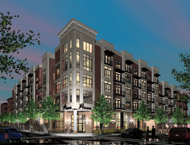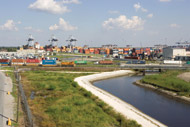|
COVER STORY, JANUARY 2009
SOUTHEAST OUTLOOK 2009
Jon Ross
As the commercial real estate industry ends another year and heads into the next, Southeast Real Estate Business continues its tradition of looking back on performances of certain property types in different regions of the Southeast in 2008 and what to expect for those markets in 2009. The area’s retail and office markets were explored in December; this issue includes reports evaluating the Birmingham, Alabama, and Miami industrial markets and the multifamily sector in places like Baltimore and Raleigh, North Carolina.
2009 SOUTHEAST MULTIFAMILY OUTLOOK
Raleigh
 |
Crosland will deliver 712 Tucker in Raleigh, North Carolina, this summer.
|
|
At the end of 2006, the Raleigh multifamily market sat on the cusp of a huge growth spurt. Apartment complexes soon started popping up on a steady basis: 3,222 units were delivered into the area in 2007. In 2008, that number tapered off a bit. More than 2,100 units have been delivered so far this year, and 2,840 units are currently under construction.
“Generally speaking, the triangle apartment market is healthy,” says Jim Scofield, senior investment advisor in Sperry Van Ness’ Raleigh office. Scofield says the market occupancy rate is steady at 91.3 percent, and year-to-date cap rates are respectably low at 5.53 percent. “This is not to say that everything will remain rosy. Increased supply in the face of waning demand will surely lead to further declines in pricing and increases in cap rates.”
 |
Night falls on the 205-unit Residences at the Arboretum in Raleigh, North Carolina.
|
|
A handful of major complexes are slated for completion in the Triangle in 2009. Trammell Crow Residential’s 288-unit Alexan Panther Creek and the 205-unit Residences at the Arboretum by Crosland are both located in Cary. The 300-unit Crossings at Alexander Place, the 344-unit Legacy Crossroads by the Goldberg Companies and the 378-unit Villas at Centerview are also under development. Another Crosland development, 712 Tucker, will bring 179 units to the area when completed this summer. But the sluggish economy is always in the picture.
“Renters are finding it increasingly difficult to absorb rent increases,” Scofield says. “Growth in effective rents will decline, for sure, in 2009.”
Atlanta
For Josh Goldfarb of Southeast Apartment Partners in Atlanta, it’s hard to know how long into 2009 the multifamily market will keep rolling downhill. He points to a number of reasons why the outlook for this year’s apartment market is bleak.
“Without attractive lending programs or capital sources, less qualified yet still capable buyers will be eliminated from acquisitions. Of those remaining, the more costly the equity, the lower the offering price. Unless owners are strongly motivated to sell, the sales market will remain stagnant,” he says. “At the property performance level, job loss will be the biggest factor for obvious reasons — less money to pay the rent.”
And the trend may be here to stay. With no major developments on the horizon and a paucity of transactions predicted, the Atlanta multifamily market will take more than half the year to turn around.
“Looking out beyond 9 months, a period of time that typically represents a marketing-to-close period,” he continues, “it is difficult to predict.”
In the Atlanta market, Goldfarb is seeing investors in multifamily assets hurting, with both the value and the number of multifamily transactions down. Property owners are doing well on the operations side, but buyer and sellers have vanished. This leads Goldfarb to put his faith for the next year in infill projects instead of new developments.
“Most projects in Atlanta have been put on hold unless they are already committed,” he says. “Infill projects still lead the way in the metro Atlanta area.”
Miami
 |
The 225,000-square-foot Beacon Lakes will deliver this summer in Miami.
|
|
In Miami, the multifamily market is primed and ready for its next delivery of 795 units — a more than 200 unit increase from 2008’s totals. Red Road Commons will contribute 400 units, and Morrison Apartments should add 395 units, but neither is slated to come online until 2010. That means, for the next year, the Miami multifamily market will receive no new units.
“Apartment supply growth remains largely in check in the county,” says Kirk Felici of Marcus & Millichap’s Miami office. “Permitting activity has declined, and the development pipeline continues to contain a limited number of projects. In addition, a weak labor market is curtailing housing demand.”
Though the current prognosis is dire, Felici believes the multifamily market might start making a comeback in the next few months. In the last 6 months, there’s been an increase in sales activity, and cap rates have settled at 7.5 percent. “In the months ahead, activity is likely to center on assets in high-density or desirable areas, such as beachfronts, and on properties near major roads and public transportation,” he says.
For the near future, transactions will be limited to smaller apartments, those with between 10 and 100 units. Higher vacancy rates will become a trend, as unemployment takes its toll on the area. There is, however, hope for multifamily landlords, Felici says.
“Savvy operators will be able to reduce insurance expense and property taxes through challenges with the county appraiser.”
Baltimore
During the past 5 years, the multifamily market in Baltimore has been thriving. According to Robin Williams, a senior vice president in Transwestern’s Baltimore office, close to 3,000 new units were delivered from 2003 to 2008. Williams attributes the flurry of activity to the Base Realignment and Closure (BRAC) campaign. He predicts the future will be busy for developers.
“In anticipation of a BRAC-related surge in demand, multifamily development in the corridor has intensified,” William says, noting that 2,700 units have delivered in the past 36 months because of base closures. “Despite the current turbulence in the capital markets, another 1,300 units near the base currently are under construction or are planned to start within 12 months.”
The BRAC campaign began in 2005 and must be completed by 2011. For the Baltimore area, it entails relocating 10,000 to 15,000 workers to Fort Meade in Anne Arundel County. Williams says BRAC’s local economic impact is estimated at $5 billion. But BRAC isn’t just good for new developments. Williams estimates that $1.5 billion in multifamily properties have been traded since the plan was announced. This activity points to a multifamily market closely tied to base closures.
“While recent troubles in the capital markets may decelerate building and sales activity region-wide during the coming months, BRAC’s enormous impact on the Baltimore-Washington Corridor will be difficult to impede,” he says. “The real estate community appears almost unanimously optimistic about the Baltimore-Washington Corridor’s future.”
2009 SOUTHEAST INDUSTRIAL OUTLOOK
Louisville
The Louisville industrial market may have broken some records last year. An overall solid performance was capped off by a huge showing in net absorption. “Fourth quarter results are not yet in, but we figure we’ll be in the 4 million-square-foot range, possibly eclipsing our current record standing at 3.9 million square feet in 2006,” says Stephan Gray of Louisville-based Commercial Kentucky. The average absorption rate for the area, he says, is 2 million square feet. Vacancy rates currently stand at 8.7 percent.
Into this stable environment, developers will add four new properties totaling more than 2 million square feet. Lauth will deliver a 936,000-square-foot building at the Salt River Business Park. In the Southern Indian submarket, Capstone Realty is almost finished with its 607,500-square-foot space at River Ridge Commerce Center II and Cross Dock Development is working on a 450,535-square-foot project. To cap it all off, Duane Realty will deliver 207,000-square-feet at Jennings Crossing. When building expansions are taken into account, the amount of new industrial space tops 2.5 million square feet.
“Add to that the available Class A space currently vacant, and the metro area has over 5 million square feet of Class A product,” Gray says. “This is 2 or 3 years of inventory given our annual average net absorption.”
Even with the amount of space coming online in 2009, Grays says its hard to predict the health of the industrial market. All this space doesn’t mean tenants will be ready to snatch it up when it delivers. “Market demand is the biggest single factor that will affect the market next year, and it is anybody’s guess as to what that demand will look like,” he says. “We are in unprecedented economic territory today. We’ll go through a sustained period of corporate contraction and layoffs, followed by increased profits and expansions. Unfortunately there is no way to determine how long the cycle will take.
Gray, however, is hopeful about the coming year. “Louisville has historically weathered tough economic times well. Our area doesn’t typically have the large swings in growth and decline as some of the major markets do,” he says. “We remain optimistic that our fundamentals will keep us strong.”
Charlotte
On the surface, the Charlotte industrial market seems to be in good shape. Developers historically haven’t flooded the city with industrial product, so there currently aren’t massive amounts of vacant warehouses that need occupants. In fact, the market’s 11 percent vacancy rate is a respectable showing. But in a market boasting 30 million square feet of industrial space, only 250,000 square feet is on tap for 2009 and 1.7 million square feet is in the pipeline.
“If all 1.7 million square feet were to be built — which won’t happen — it would represent a 5.7 percent increase in inventory,” says Rob Speir, vice president of Charlotte-based Keystone Partners. “There will not be any significant product started until 2010, resulting in flat inventory levels for the next 18 to 24 months.”
Speir attributes the market’s health to developers that didn’t build needless projects during Charlotte’s real estate boom, which started in 2005 and lasted until 2007. Major developers such as Childress Klein Properties, The Keith Corporation, M. David Properties and ProLogis were responsible with their development schedules, he says. This slower level of construction led to an average absorption rate of 1.5 million square feet. Speir expects the market to fall short of that mark in 2009. Also complicating the outlook for 2009 is Wells Fargo’s purchase of Wachovia, a major employer of Charlotte’s 1.7 million-strong workforce. Speir points out, however, that DCT Industrial Trust, TA Associates, EastGroup Properties, RREEF, J.P. Morgan and other institutional investors will help keep market inventory leased up, even in the tough times ahead.
“The future will not be easy. Experts agree that cap rates are rising and values will normalize,” he says. “However, due to sound fundamentals and a disciplined development community, Charlotte’s industrial market will be a healthy investment vehicle for both private and institutional investors well into the future.”
Savannah
 |
Right: The port in Savannah, Georgia, helps draw industrial development.
|
|
Renewal is the name of the game in the Savannah industrial market. Leasing for existing properties has kept the market afloat while leasing activity for new buildings has been slowly declining.
“Existing business remains steady,” says Sam O’Briant, executive vice president of the Southeast region at Duke Realty. That business is closely tied to activity at the Port of Savannah, where the 2008 total of equivalent units will reach 2.6 million. “We expect volume to remain at around the mid-2 million TEU range next year. This will keep existing logistics and warehousing businesses active in 2009, but we expect growth and demand for new buildings to be spotty.”
The lack of new industrial developments in the area leads O’Briant to make a prediction about the health of the market next year. Instead of focusing on new projects — O’Briant doesn’t foresee any major developments delivering in 2009 — landlords will most likely stick to securing tenants for current vacancies.
“The percentage of renewing tenants will be above historical averages next year,” O’Briant says. “Landlords will aggressively seek to retain existing tenants, and most tenants will defer growth plans for a while. New construction has largely stopped or been significantly reduced in most markets, including Savannah.”
He remains hopeful, however, that an influx in the population of Southern cities brought on by migration from other parts of the county will help fuel a market resurgence.
“2009 will likely be a year where we work through some of the excesses from prior years.”
2009 SOUTHEAST OFFICE OUTLOOK
Miami
This summer, the developer AMB will deliver Beacon Lakes, a 225,000-square-foot spec warehouse at the intersection of the Dolphin Expressway and the Florida Turnpike in Miami. This single development represents the current industrial market in the area, says Ron Berger of CB Richard Ellis’ Miami office. “All the other major developers have placed construction of multi-tenant warehouse facilities on hold for the foreseeable future,” he says.
In August 2007, the industrial market was looking up. Sales were at an all-time high, and product was moving. Current activity is restricted to leasing warehouse space smaller than 20,000 square feet. Tenants simply aren’t interested in the larger buildings, those that span more than 40,000 square feet. The struggling economy is at the center of the industrial slowdown. “Because of lower U.S. consumer spending, the volume of train shipments is going to diminish, the number of cruise ship passengers is going to diminish, the number of airline travelers is going to diminish, and all that is going to have ripple to significant impacts on the industrial marketplace,” says Jeremy Larkin of NAI Miami.
How does Miami jumpstart activity in the industrial arena? Berger says rebuilding the Miami market will be a slow, difficult task. “The first and second quarters will be a repeat of the slow fourth quarter of 2008,” he says. “The fourth quarter of 2009 will be the best quarter of the year. Industrial leasing and sales activity will be much stronger with greater positive activity than today’s market conditions.”
With one development on tap for next year and a gloomy outlook, the vacancy rate sits at a respectable 5.2 percent. Like everyone else, Miami landlords and tenants are worried. Until the market settles down, warehouse transactions will stay minimal. In spite of Berger’s forecast, Larkin says the Miami industrial market is still healthy. “We’re still a large metropolitan marketplace driven by a global market,” he says. “High-value perishable stuff is moving through the marketplace that has to get from Point A to Point B.”
“Companies big and small are simply not comfortable with the current state of the financial unrest we are experiencing,” Berger says. “Just like the turtle, they are pulling their heads in and riding out the financial storm until the sun shines again.”
Orlando
Like many other markets that are reeling from the economy’s domino effect on pricing, the industrial market starts with the housing industry. When consumers are saddled with ballooning mortgages, disposable incomes dry up. Retailers feel the resulting pinch, and industrial landlords start to lose retail tenants.
“Retailers comprise a significant portion of the industrial leasing market,” says David Murphy of CB Richard Ellis’ Orlando office.
Even though Orlando residents are struggling with expensive mortgages, Ellis classifies Orlando’s industrial health in 2008 as “resilient,” citing a steady leasing climate and small increases in vacancy rates. There has been a reduction in the price of industrial buildings for sale, and land prices have fallen.
“We have not seen significant reductions in rental rates,” he says, “and landlords have generally been able to retain their existing tenant bases with few exceptions.”
There are still a few new developments on tap for next year. Industrial Developments International should deliver its 359,950-square-foot warehouse at the Lakeview Distribution Center just north of Orlando in June. Also, 1 million square feet of industrial flex product is planned for development next year in the International Corporate Park. Despite a relative shortage of new projects, Murphy retains a positive outlook about 2009’s industrial market.
“There are excellent opportunities in the market for companies that are committed for the long term,” he says. “There is a pent up demand for space that will likely be realized once market conditions in the national economy stabilize.”
Birmingham
In Birmingham, the industrial market is broken down into two categories: heavy and bulk. The heavy industrial market, which consists of steel work and the manufacture of raw materials, is active and has been healthy for most of 2008. Rail-served sites continue to do well in the current market. On the other hand, the bulk distribution market, which has been slow for most of 2008, will take time to regain some of its luster. Ogden Deaton, senior vice president of Birmingham-based Graham & Company, says activity in the bulk market will only increase after the first quarter, and new developments aren’t even on the table.
“There is no development of bulk warehouse planned for 2009,” he says, “and we don’t anticipate any in our market for at least 12 to 18 months. We should start seeing some positive absorption by the latter part of 2009.”
Like his colleagues in other regions across the Southeast and in almost every property type, Deaton points to declining consumer confidence as one of the major reasons the industrial market is limping along. But once the economy gets back on track, he says, the Birmingham industrial market should regain activity.
“Increased consumer confidence will hopefully reignite the bulk market.”
©2009 France Publications, Inc. Duplication
or reproduction of this article not permitted without authorization
from France Publications, Inc. For information on reprints
of this article contact Barbara
Sherer at (630) 554-6054.
|
